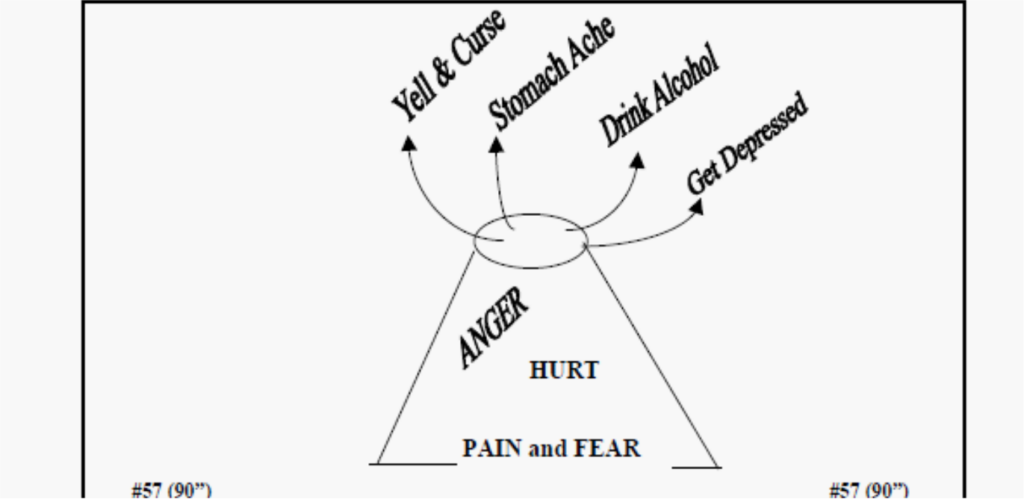Life is different after cancer treatment
After cancer treatment and remission, it’s common to be faced with confusing messages. You may find yourself thinking thoughts like the ones below.
- What if it comes back?
- What if these side effects never change?
- How come I feel different than I used to before cancer?
- How come some friendships/relationships have ended?
- I can’t do my old career/job. What am I going to do now?
- My family/friends want the “old” (insert your name) back, but what if they aren’t the same anymore?
- My cancer has been in remission for X number of years, but why are the emotions showing up now or not going away?
- People venting about “silly things” get on my nerves. Be grateful for life and every day you receive.
Let’s review tools for identifying emotions relating to life after cancer treatment and how to have difficult conversations.
Emotions After Cancer Treatment
The Shame Game
Whether we realize it or not, shame can accompany the cancer journey:
- I feel bad that my loved one had to care for me
- My children didn’t have a “normal” childhood
- Sometimes, I wasn’t nice when I didn’t feel well
- My body is different after treatment, and I don’t want people to see it
- I sure enjoyed meeting Ann at infusion, and then she died. Why did I live, and she died?
- I should have……
- If only I had…….
Shame comes from guilt, so let’s reframe that emotion.
If this isn’t guilt, then what is it?
What is Guilt?
Guilt comes from the fact of having committed a specified or implied offense or crime. Guilt is feeling self-conscious and experiencing a sense of distress about your potential responsibility for a negative outcome.
Ask yourself:
- Did I really do something wrong?
- Why do I feel guilty?
Reframing Guilt as Regret
Regret is felt when you inadvertently caused pain or harm (perceived or real) to someone and that you wish you could change the past. You may feel sad, repentant, or disappointed over something that has happened or been done, especially a loss or missed opportunity.
Ask yourself:
- Is it really regret that I am feeling?
- Do I wish I had done something differently?
“Regret acknowledges that I made a mistake. Shame says that I AM a mistake, and guilt is what others use to try to make us feel ashamed..”~ Bill Crawford
The Anger Volcano
It may not seem like anger is often masking other emotions, but often, pain and fear are the underlying emotions causing anger.
Think of a current situation that has made you angry. Can you consider what might have hurt or been fearful that caused the anger?
Am I sad, or is this depression?
To feel “down in the dumps” at times – especially after cancer treatment – is normal. However, to feel continuously “pulled down” or “in a black cloud” is serious. Depression has many signs and symptoms.
Depression that requires treatment is diagnosed by a cluster of symptoms, not just one sign. Physicians and mental health professionals use several signs to determine if a person is depressed and requires treatment.
Signs of Depression
- Loss of pleasure in previously enjoyed activities
- This can be a significant sign of depression. Problems and emotional pain outweigh pleasure. Apathy and withdrawal are common. A person frequently feels “I just don’t care about anything.”
- Pervasive sadness
- A low mood that is experienced continuously, and it affects every aspect of life.
- Appetite changes
- This can be either a loss of appetite or overeating.
- Decreased concentration and difficulty with decision-making
- Difficulty thinking clearly; may be forgetful and unable to focus, and the simplest decision may be overwhelming.
- Low self-esteem
- Lack of confidence and low self-image is common with serious depression. A person may think, “I’m no good,” or “I can’t do anything right.”
- Sleep difficulties
- This may include sleeping too much, being unable to get to sleep, or awakening in the early morning and being unable to get back to sleep.
- Fatigue/loss of energy
- Feelings of exhaustion, even after a good night’s sleep or a good rest.
- Abnormal restlessness
- Nervous energy and not being able to “settle down.”
- Preoccupation with thoughts of suicide
- A pervasive feeling of hopelessness. May or may not have a plan to commit suicide.
Treating Depression
- Physical Examination: The first step in the treatment of depression is to get a physical examination. Sometimes, medication or a health problem can cause us to become depressed or contribute to depression.
- Antidepressant Medications: Depression can be caused by chemical changes in the brain. Medication helps to bring brain chemicals back into balance. Treatment for depression often is a combination of medication and talk therapy.
- Talk/Cognitive Therapy: Talk therapy can help us to better manage our thoughts, situations, and relationships that may be causing us to become depressed. Cognitive therapy is one form of talk therapy. It helps people to identify and change negative thinking and negative self-talk. Positive self-talk helps combat depression.
Remember, if you experience signs of depression for two weeks, get help!
Regain Power Through Words
The use of “I” can move communication forward and create better conversations. “You” messages unintentionally irritate people because they sound accusatory, blaming, or hostile. They get a conversation off track. People focus on THEIR irritation or hurt feelings, not on what you intended to say.
“I” messages help keep a conversation on track. They are a good way to express our feelings and our needs. “I” messages usually begin with the word. For example: “I feel…,” “I need…,” “I have a problem with…,” “I believe…,” or “I am concerned about…”
With “I” messages, we do not put blame on others for how we feel. We take ownership and responsibility for our own feelings. We say how we feel, not how someone else makes us feel.
We want to be sure that what we say is a genuine “I” message. Sometimes, statements beginning with the word “I” can have a blaming tone because they carry a hidden “You” message. “Hidden You” statements begin with words like “I feel…,” “I am concerned…,” and “I need…,” but then, they are followed by a “You” message. These “Hidden You” messages also cause people to become defensive.
Our communication will improve if we move from blaming to heartfelt messages. Let’s turn those “you” statements into “I “ statements. Make sure you watch for hidden “you” statements.
- “YOU”: You don’t understand
- “Hidden YOU”: I feel that you don’t understand
- “I”: I don’t feel understood
How to Have Tough Conversations?
After cancer treatment, you may have new needs or boundaries that must be communicated. However, communicating these boundaries can be difficult. DESC allows you to have difficult conversations in an assertive and non-defensive manner.
Describe, Express, Specify, and Consequence
Assertiveness can be broken down into four manageable steps, according to Sharon Bower, a communications specialist.
- Describe observable behavior or problem.
- Express how you feel.
- Specify what needs to happen or to be done.
- Consequence
DESC PRACTICE
Think about a person – a family member, a health care professional, a friend, a staff member, or anyone – with whom you would like to communicate more assertively, set limits, or ask for help.
- Describe observable behavior or problem: Clearly state what happened or is bothering you. Do this without emotion, evaluation, or exaggeration. Focus on the behavior or the problem, not the person.
- Express how you feel: State your feelings without blaming the other person and without giving your opinion about the reasons for the person’s behavior. For example, state: “I feel ______ about what happened.”
- Specify what needs to happen or to be done.: For example, state: “I want/I need ___________.”)
- Consequence: A consequence is saying what will happen if what you said under “Specify” does or does not happen. It’s important not to blame, bluff, or threaten. You want to say something like, “If __________ happens, then I will __________”. Remember, a consequence can be either negative or positive.
How to Have Conversations Which Help Align the Issue
Let’s go over a communication tool called Aikido or alignment. Aikido is particularly useful for calming strong emotions and finding common ground with another person. It helps to restore harmony and to create a feeling of “working together” in emotionally charged situations.
Aikido is based on the principles of the Aikido School of Martial Arts. It emphasizes the importance of learning what a distressed person needs so you can align or “move with” the person rather than give in or fight to win.
Aikido is a communication tool that can help another person feel that we understand their feelings and point of view. A person who feels heard and validated is more likely to work with you to find solutions to problems and concerns.
The goals of Aikido are:
- To create or regain a feeling of harmony between ourselves and the other person.
- To help the other person feel we have heard him/her.
- To help the person
Align – Alignment is the key to Aikido. Without aligning, you cannot move forward. As you observe and listen to someone, put yourself “in that person’s shoes.” The goal is to help the person meet some of their needs without sacrificing your own needs. Ask yourself, “What does this person need or want from me to feel better?”
Is it:
- to feel heard, understood, and appreciated?
- to be right?
- to express emotions?
- to receive recognition?
- to save face?
- to impress me?
Agree – You look for areas of agreement or common ground, no matter how small that common ground might be.
Redirect – You redirect the conversation to those areas of agreement or common ground. The idea behind redirecting is to move the conversation in a positive direction so that you can work toward resolution or change.
Resolve – You seek to resolve differences by:
- finding a middle ground you can live with
- finding a common concern you can work on or deciding to agree to disagree
When you find common ground, harmony is more likely to follow.
Transitioning into the New After Cancer Treatment
- Endings – Endings involve “letting go” of the old, of “what was.”
- Wilderness Period – This is the time between the old and the new. It can feel like a “no man’s land.” It’s necessary to spend some time in the “wilderness” period to come to terms with and accept what has ended.
- New Beginnings – A new beginning is achieved only after we have dealt with what has ended and spent the necessary time in the wilderness period. It’s a time when we start to “move forward.”
A transition is the “business” of finishing “the old” so we can begin anew.
Take a moment to reflect on where you are currently. Life after cancer treatment will often look and feel different than before you started. We hope these emotional and conversational tools can help you navigate the emotions that arise after your cancer treatment is completed.
Thank you to Tracey Willingham, Vice President of Client Programs, for creating this presentation on “Caring for the New You.” If you would like to practice and view examples of the conversation tools, please download the presentation.
Cancer Care Services is here to help so that no one has to cope with cancer alone! We can help you find resources and will determine if you are eligible for our assistance programs, such as gas or medication assistance. We can also connect you with in-house social events. Contact us today at 817-921-0653 or fill out our online form. We look forward to helping you!



